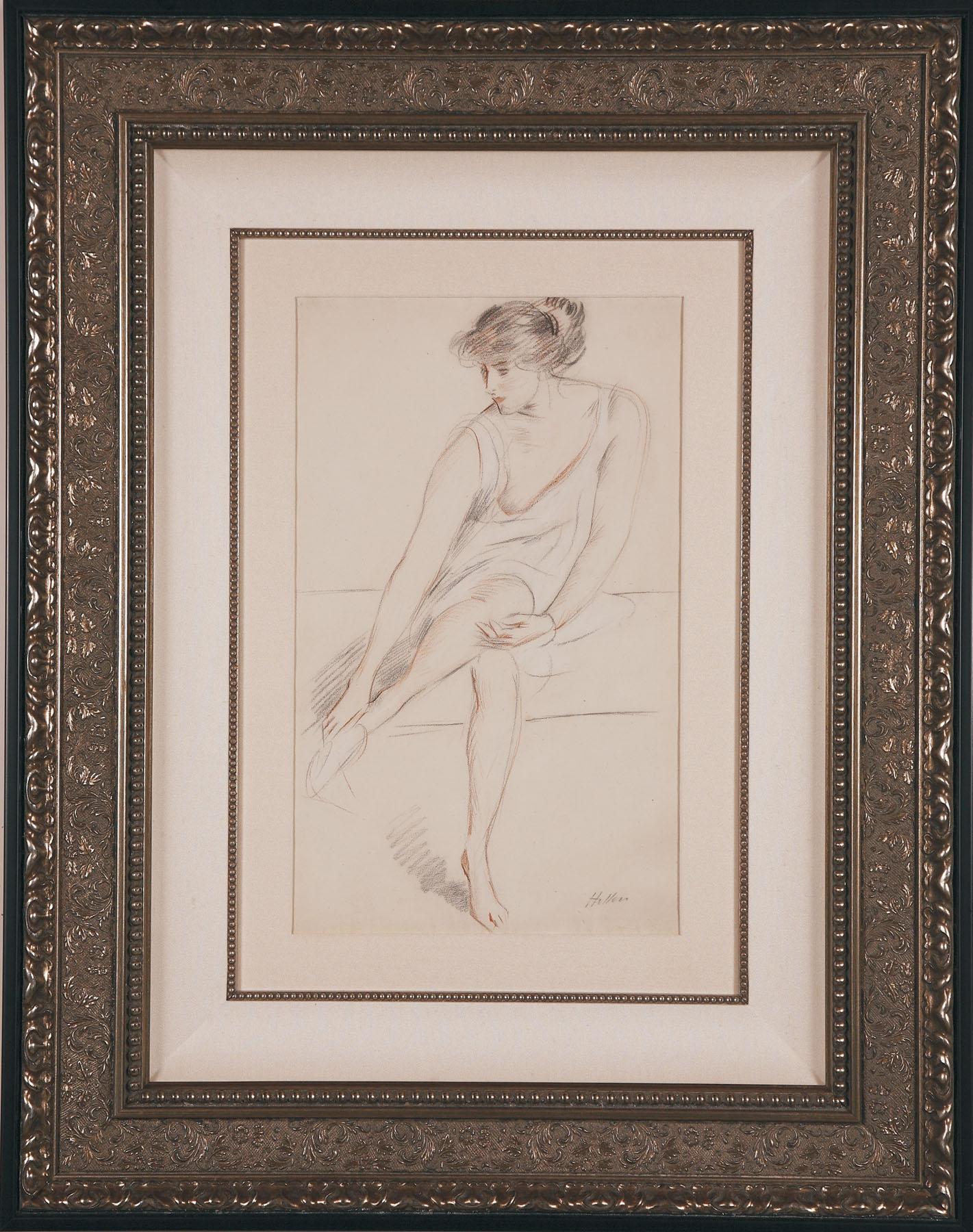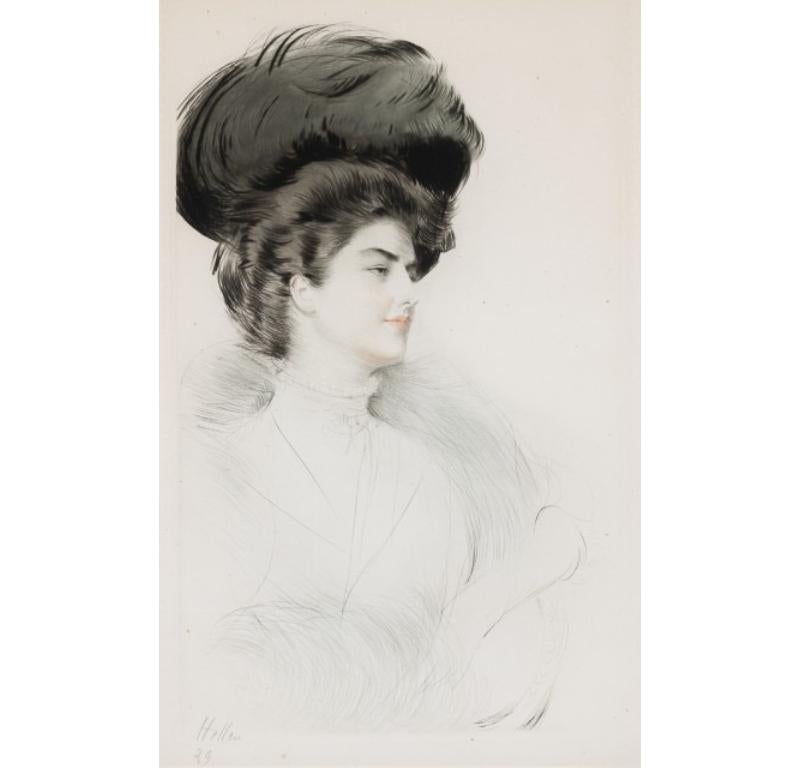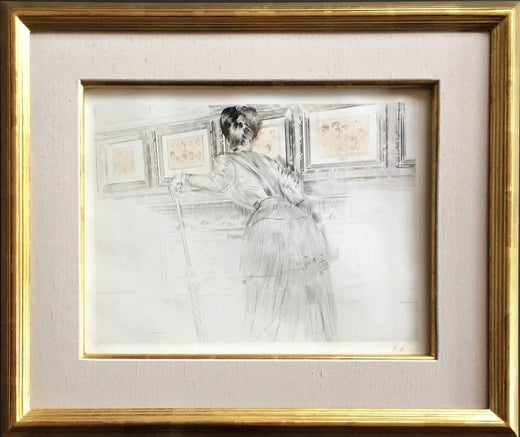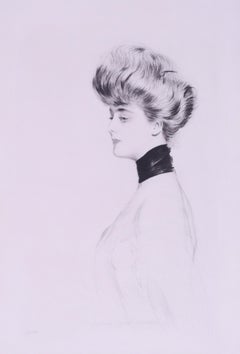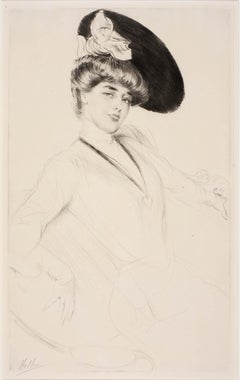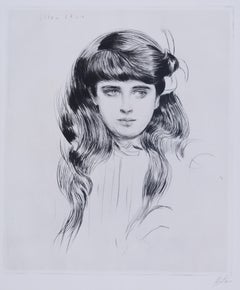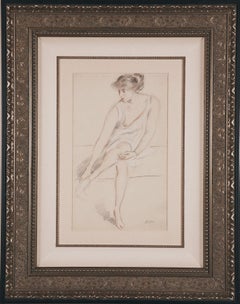Items Similar to Untitled (Young woman seen from the back)
Want more images or videos?
Request additional images or videos from the seller
1 of 10
Paul César HelleuUntitled (Young woman seen from the back)c. 1910
c. 1910
$7,500
£5,664.78
€6,546.85
CA$10,519.90
A$11,700.83
CHF 6,123.96
MX$142,711.52
NOK 76,949.82
SEK 72,381.24
DKK 48,865.91
About the Item
Untitled (Young woman seen from the back)
Sanguine crayon, charcola and watercolor on paper, c. 1910
Signed with the estate stamp, Lugt 5169 lower left corner
Provenance:
Estate of the artist (see estate stamp signature)
Galerie J. Le Chapelin, 71 Rue Faubourg Saint-Honoré, Paris (highly respected gallery in the 1950s)
Private Collection, New Jersey
Condition: Slight vertical crease in the paper left side of image.
Tiny spots of staining.
Image/Sheet size: 11 1/2 x 11 3/4 inches
Paul César Helleu was born in Vannes, Brittany, France. His father, who was a customs inspector, died when Helleu was in his teens. Despite opposition from his mother, he then went to Paris and studied at Lycée Chaptal. In 1876, at age 16, he was admitted to the École des Beaux-Arts, beginning academic training in art with Jean-Léon Gérôme. Helleu attended the Second Impressionist Exhibition in the same year, and made his first acquaintances with John Singer Sargent, James McNeill Whistler, and Claude Monet. He was struck by their modern, bold alla prima technique and outdoor scenes, so far removed from the studio. Following graduation, Helleu took a job with the firm Théodore Deck Ceramique Française hand-painting fine decorative plates. At this same time, he met Giovanni Boldini, a portrait painter with a facile, bravura style, who became a mentor and comrade, and strongly influenced his future artistic style.
When he was 18 years old, Helleu established a close friendship with John Singer Sargent, four years his senior, that was to last his lifetime. Already becoming established, Sargent was receiving commissions for his work. Helleu had not sold anything, and was deeply discouraged almost to the point of abandoning his studies. When Sargent heard this, he went to Helleu and picked one of his paintings, praising his technique. Flattered that Sargent would praise his work, he offered to give it to him. Sargent replied, "I shall gladly accept this, Helleu, but not as a gift. I sell my own pictures, and I know what they cost me by the time they are out of my hand. I should never enjoy this pastel if I hadn't paid you a fair and honest price for it." With this he paid him a thousand-franc note.
Helleu was commissioned in 1884 to paint a portrait of a young woman named Alice Guérin (1870–1933). They fell in love, and married on 28 July 1886. Throughout their lives together, she was his favourite model. Charming, refined and graceful, she helped introduce them to the aristocratic circles of Paris, where they became popular fixtures.
On a trip to London with Jacques-Émile Blanche in 1885, Helleu met Whistler again and visited other prominent artists. His introduction to James Jacques Tissot, an accomplished society painter from France who made his career in England, proved a revelation. In Tissot, Helleu saw, for the first time, the possibilities of drypoint etching with a diamond point stylus directly on a copper plate. Helleu quickly became a virtuoso of the technique, drawing with the same dynamic and sophisticated freedom with his stylus as with his pastels. His prints were very well received, and they had the added advantage that a sitter could have several proofs printed to give to relations or friends. Over the course of his career, Helleu produced more than 2,000 drypoint prints.
Soon, Helleu was displaying works to much acclaim at several galleries. Degas encouraged him to submit paintings to the Eighth Impressionist Exhibition in May and June 1886. The show was installed in a Paris apartment at 1 rue Laffitte, which ran concurrently with the official Salon that year to make a statement. Although 17 artists joined the famous exhibit that included the first Neo-Impressionistic works, Helleu, like Monet, refused to participate.
Paul Helleu Sketching with His Wife (1889), by John Singer Sargent, The Brooklyn Museum, New York
In 1886, Helleu befriended Robert de Montesquiou, the poet and aesthete, who bought six of his drypoints to add to his large print collection. Montesquiou later wrote a book about Helleu that was published in 1913 with reproductions of 100 of his prints and drawings. This volume remains the definitive biography of Helleu. Montesquiou introduced Helleu to Parisian literary salons, where he met Marcel Proust, who also became a friend. Proust created a literary picture of Helleu in his novel Remembrance of Things Past as the painter Elstir. (Later, Helleu engraved a well-known portrait of Proust on his deathbed.) Montesquiou's cousin, the Countess Greffulhe, enabled Helleu to expand his career as a portrait artist to elegant women in the highest ranks of Paris society, portraits that provide the basis for his modern reputation. His subjects included the Duchess of Marlborough, the Marchesa Casati, Belle da Costa Greene, Louise Chéruit, and Helena Rubinstein.
Looking for new inspiration, Helleu began a series of paintings and color prints of cathedrals and stained glass windows in 1893, followed by flower studies and landscapes of parks in Versailles. Helleu took up sailing, owning four yachts over his life. Ships, harbor views, life at port in Deauville, and women in their fashionable seaside attire became subjects for many vivid and spirited works.
In 1904, Helleu was awarded the Légion d'honneur and became one of the most celebrated artists of the Edwardian era in both Paris and London. He was an honorary member in important beaux-arts societies, including the International Society of Painters, Sculptors, and Engravers, headed by Auguste Rodin, and the Société Nationale des Beaux-Arts.
On his second trip to the United States in 1912, Helleu was awarded the commission to design was the ceiling decoration in New York City's Grand Central Terminal. He decided on a mural of a blue-green night sky covered by the starry signs of the zodiac that cross the Milky Way. Although the astrological design was widely admired, the ceiling was covered in the 1930s. It was completely restored in 1998.
Helleu made his last trip to New York City in 1920 for an exhibition of his work, but he realized that the Belle Époque was over. He felt out of touch, and shortly after his return to France, he destroyed nearly all of his copper plates and retired to family life. While planning for a new exhibition with Jean-Louis Forain, he died in 1927 at age 67 of peritonitis following surgery in Paris.
Among many of his friends was Coco Chanel, who chose beige as her signature colour upon on his advice—the colour of the sand on the beach of Biarritz in early morning.
Courtesy Wikipedia
- Creator:Paul César Helleu (1859-1927, French)
- Creation Year:c. 1910
- Dimensions:Height: 11.5 in (29.21 cm)Width: 11.75 in (29.85 cm)
- Medium:
- Movement & Style:
- Period:
- Condition:Slight vertical crease in the paper left side of image.
- Gallery Location:Fairlawn, OH
- Reference Number:Seller: FA90781stDibs: LU14014346032
Paul César Helleu
Rich impression with dramatic drypoint burr and tone no other artist epitomizes the whole atmosphere of elegance and hedonistic pleasure which pervaded Paris society at the first decade of the century as does Helleu. A close friend of Proust and the inspiration for one of the principal characters in La Recherche du Temps Perdu, Helleu’s whole life style echoed the incomparable elegance and flow of his drawing, the sheer style of his art, and his eye for the poses of the beautiful women who were his friends and his patrons. During the 1870’s, Helleu had come to know the painters of Impressionism and also artists Sargent and Whistler who became his special friends and inspiration. By the early 1880’s, he had already developed the quality of expressive sweeping line, which is the essence of his drawing, but in 1885 he was encouraged by Tissot to try working on prints in drypoint. At this time, Tissot had decided, after the death of his lover and model Kathleen Newton, to travel to the Holy Land on an artistic pilgrimage. Having decided he would no longer engrave, he gave Helleu his diamond stylus…a literal and figurative “passing of the baton”. It was in the incision and texture of drypoint that his art was to reach one of its greatest peaks. He had an innate feel for the balance between a lightly curving stroke and the deeply cut highly tonal burr of the strongest drypoint. Around the turn of the century he started to combine drypoint with multi-inking in colors, the areas of color restricted to such touches as the bows on the hats, the hair color or the red of the lips. The plate was drawn at a single sitting, and then the color inks were brushed onto it. The results are some of the most splendid and decorative of all Belle Époque prints.
About the Seller
5.0
Recognized Seller
These prestigious sellers are industry leaders and represent the highest echelon for item quality and design.
Gold Seller
Premium sellers maintaining a 4.3+ rating and 24-hour response times
Established in 1978
1stDibs seller since 2013
808 sales on 1stDibs
Typical response time: <1 hour
Associations
International Fine Print Dealers Association
- ShippingRetrieving quote...Shipping from: Fairlawn, OH
- Return Policy
Authenticity Guarantee
In the unlikely event there’s an issue with an item’s authenticity, contact us within 1 year for a full refund. DetailsMoney-Back Guarantee
If your item is not as described, is damaged in transit, or does not arrive, contact us within 7 days for a full refund. Details24-Hour Cancellation
You have a 24-hour grace period in which to reconsider your purchase, with no questions asked.Vetted Professional Sellers
Our world-class sellers must adhere to strict standards for service and quality, maintaining the integrity of our listings.Price-Match Guarantee
If you find that a seller listed the same item for a lower price elsewhere, we’ll match it.Trusted Global Delivery
Our best-in-class carrier network provides specialized shipping options worldwide, including custom delivery.More From This Seller
View AllPortrait de femme en buste, de profil a gauche, un tres large ruban noir du cou
By Paul César Helleu
Located in Fairlawn, OH
Portrait de femme en buste, de profil a gauche, un tres large ruban noir du cou, Mme Marthe Letellier
Drypoint, 1900-1901
Signed in pencil lower left (see photo)
Titled in pencil low...
Category
Early 1900s Impressionist Figurative Prints
Materials
Drypoint
Miss Taylor
By Paul César Helleu
Located in Fairlawn, OH
Miss Taylor
Drypoint, c. 1900
Signed in pencil lower left (see photo)
Small edition, about 10
Very rich impression, full of burr
Condition: Excellent
Image size: 21-1/4 x 13-1/4"
She...
Category
Early 1900s Art Nouveau Portrait Prints
Materials
Drypoint
Portrait de petite fille, en buste, cheveux sur les epaules (Ellen 14 ans)
By Paul César Helleu
Located in Fairlawn, OH
Portrait de petite fille, en buste, cheveux sur les epaules (Ellen 14 ans) Portrait of a little girl, bust, hair on shoulders)
Drypoint, 1902
Signed lower right corner
Very small ed...
Category
Early 1900s Art Nouveau Figurative Prints
Materials
Drypoint
Standing Woman in Profile
By Frederick Carl Frieseke
Located in Fairlawn, OH
Standing Woman in Profile
Pen and ink drawing, c. 1900
Unsigned
Estate authentication verso by Frances Frieseke Kilmer (Mrs. Kenton Kilmer, 1914-1998) (see photo)
Condition: Excellen...
Category
Early 1900s American Impressionist Figurative Drawings and Watercolors
Materials
Ink
Woman Pulling on a Slip
By Everett Shinn
Located in Fairlawn, OH
Woman Pulling on a Slip
Conte on paper, c. 1910
Signed lower right: "E. Shinn" (see photo of legs, signature on right)
Provenance:
Estate of the Artist (see label)
Graham Gallery, N...
Category
1910s Ashcan School Nude Drawings and Watercolors
Materials
Conté
Side View Seated Female Nude
By Frank Duveneck
Located in Fairlawn, OH
Side View Seated Female Nude
Graphite on paper, c. 1890's
Unsigned
Provenance:
Rookwood Pottery Factory Collection, Cincinnati
Spanierman Gallery, New York (label)
Drawings from the...
Category
1890s American Impressionist Nude Drawings and Watercolors
Materials
Graphite
You May Also Like
Original Drawing "Jeune Femme Assise" by Paul Cesar Helleu, c. 1910
By Paul César Helleu
Located in Hinsdale, IL
HELLEU, PAUL CÉSAR
(1859 -1927)
"JEUNE FEMME ASSISE"
(Young Woman Seated)
Original Drawing in sanguine, white and black chalks, c. 1910
Signed in pencil by artist, lower right
Full M...
Category
Early 20th Century Impressionist Figurative Drawings and Watercolors
Materials
Chalk, Carbon Pencil
Original Drawing "Jeune Femme Assise" by Paul Cesar Helleu, c. 1910
By Paul César Helleu
Located in Hinsdale, IL
HELLEU, PAUL CÉSAR
(1859 -1927)
"JEUNE FEMME ASSISE"
(Young Woman Seated)
Original Drawing in sanguine, white and black chalks, c. 1910
Signed in pencil by artist, lower right
Full Margins on cream wove paperImage size: 17.5” x 11.02”
Paul César Helleu...
Category
Early 20th Century Impressionist Figurative Drawings and Watercolors
Materials
Chalk
Shy Red Hair Woman - Lithograph
By Paul César Helleu
Located in Paris, IDF
Paul César Helleu
Shy Red Hair Woman, 1913
Lithograph and watercolor stencil
Printed signature
On vellum 26 x 20 cm (c. 10.5 x 8 inch)
Very good condi...
Category
1890s Art Nouveau Portrait Prints
Materials
Lithograph
Classical Studies of a Lady - Original lithograph - Printed signature, 1897
By Paul César Helleu
Located in Paris, IDF
Paul César Helleu
Paris : Classical Studies of a Lady, 1897
Original litograph
Printed signature in the plate
On vellum 40 x 31 cm (c. 16 x 12")
INFORMATION : Published by 'Estampe...
Category
1890s Art Nouveau Portrait Prints
Materials
Lithograph
Bust of a young woman in profile
By Paul César Helleu
Located in Naples, Florida
Bust of a young woman in profile
Paul-César Helleu (1859-1927)
JEUNE FEMME EN BUSTE, DE PROFIL À DROITE
Color drypoint, circa 1900, on wove paper, signed and annotated 29 in pencil,...
Category
19th Century Portrait Paintings
Materials
Paper, Drypoint, Etching
$4,250 Sale Price
50% Off
Profile of Woman - Original Drawing on Paper by E. Giraud - Late 19th Century
By Eugène Giraud
Located in Roma, IT
Profile of Woman from behind is an Original Drawing in China Ink realized by Eugène Giraud in the Late 19th Century.
Good conditions.
The delicate a...
Category
Late 19th Century Modern Figurative Drawings and Watercolors
Materials
Paper, Ink
More Ways To Browse
The Young Painter
The Woman At The Well
Young Mother
Woman Back Painting
Robert Young
Sketch Woman
Monet Drawings
Charcoal Drawing London
1889 Portrait Drawing
Central Park Watercolor
Countess Painting
Chanel Art Glass
June Felter
Antique Seaside Painting
The Starry Night
Charcoal Drawing Flowers
Zodiac Painting
Sailing Plates
